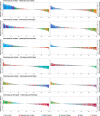Erotic subset for the Nencki Affective Picture System (NAPS ERO): cross-sexual comparison study
- PMID: 26441715
- PMCID: PMC4564755
- DOI: 10.3389/fpsyg.2015.01336
Erotic subset for the Nencki Affective Picture System (NAPS ERO): cross-sexual comparison study
Abstract
Research on the processing of sexual stimuli has proved that such material has high priority in human cognition. Yet, although sex differences in response to sexual stimuli were extensively discussed in the literature, sexual orientation was given relatively little consideration, and material suitable for relevant research is difficult to come by. With this in mind, we present a collection of 200 erotic images, accompanied by their self-report ratings of emotional valence and arousal by homo- and heterosexual males and females (n = 80, divided into four equal-sized subsamples). The collection complements the Nencki Affective Picture System (NAPS) and is intended to be used as stimulus material in experimental research. The erotic images are divided into five categories, depending on their content: opposite-sex couple (50), male couple (50), female couple (50), male (25) and female (25). Additional 100 control images from the NAPS depicting people in a non-erotic context were also used in the study. We showed that recipient sex and sexual orientation strongly influenced the evaluation of erotic content. Thus, comparisons of valence and arousal ratings in different subject groups will help researchers select stimuli set for the purpose of various experimental designs. To facilitate the use of the dataset, we provide an on-line tool, which allows the user to browse the images interactively and select proper stimuli on the basis of several parameters. The NAPS ERO image collection together with the data are available to the scientific community for non-commercial use at http://naps.nencki.gov.pl.
Keywords: Nencki Affective Picture System; emotion; erotic stimuli; heterosexual; homosexual; sexual orientation.
Figures




References
LinkOut - more resources
Full Text Sources
Other Literature Sources

